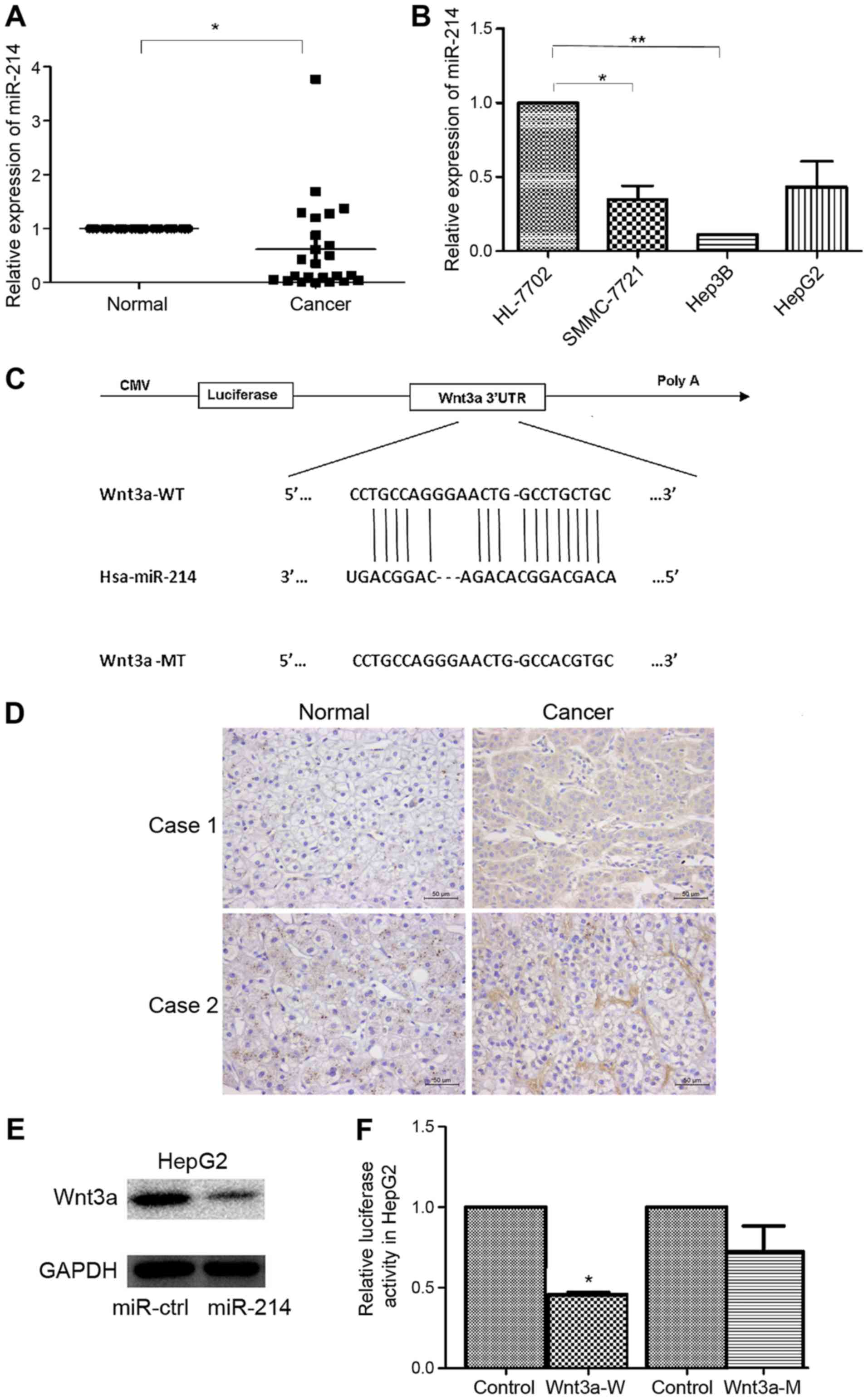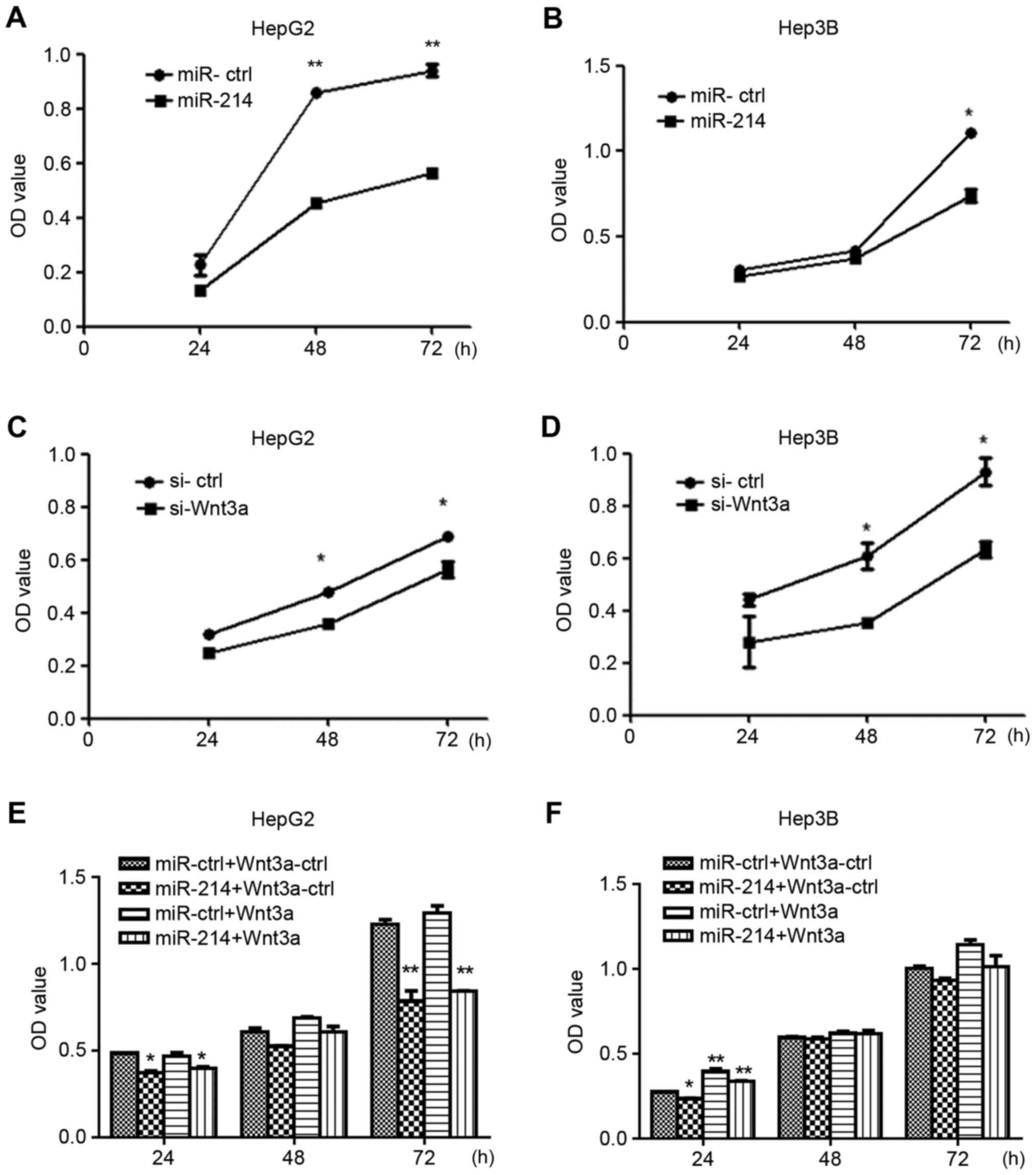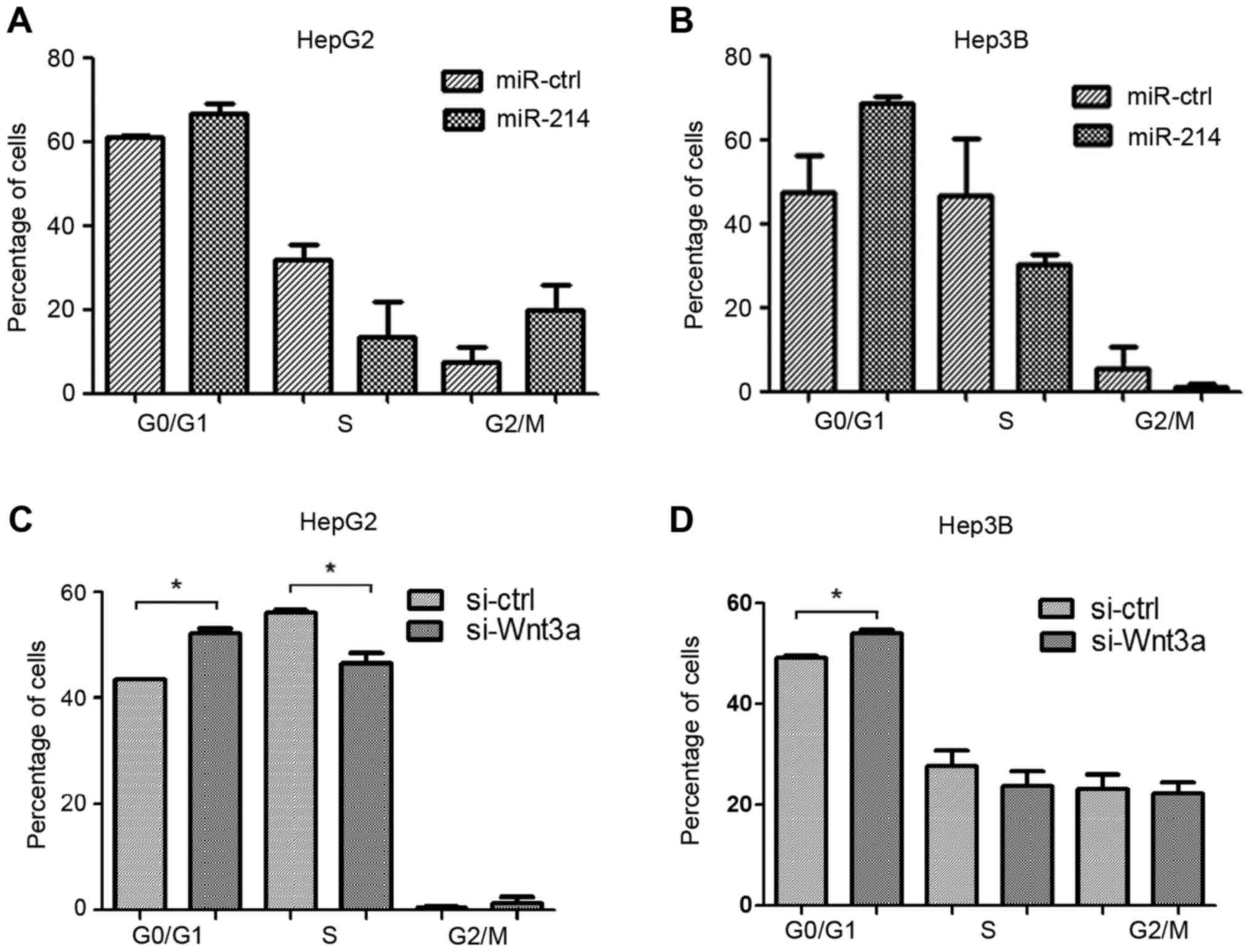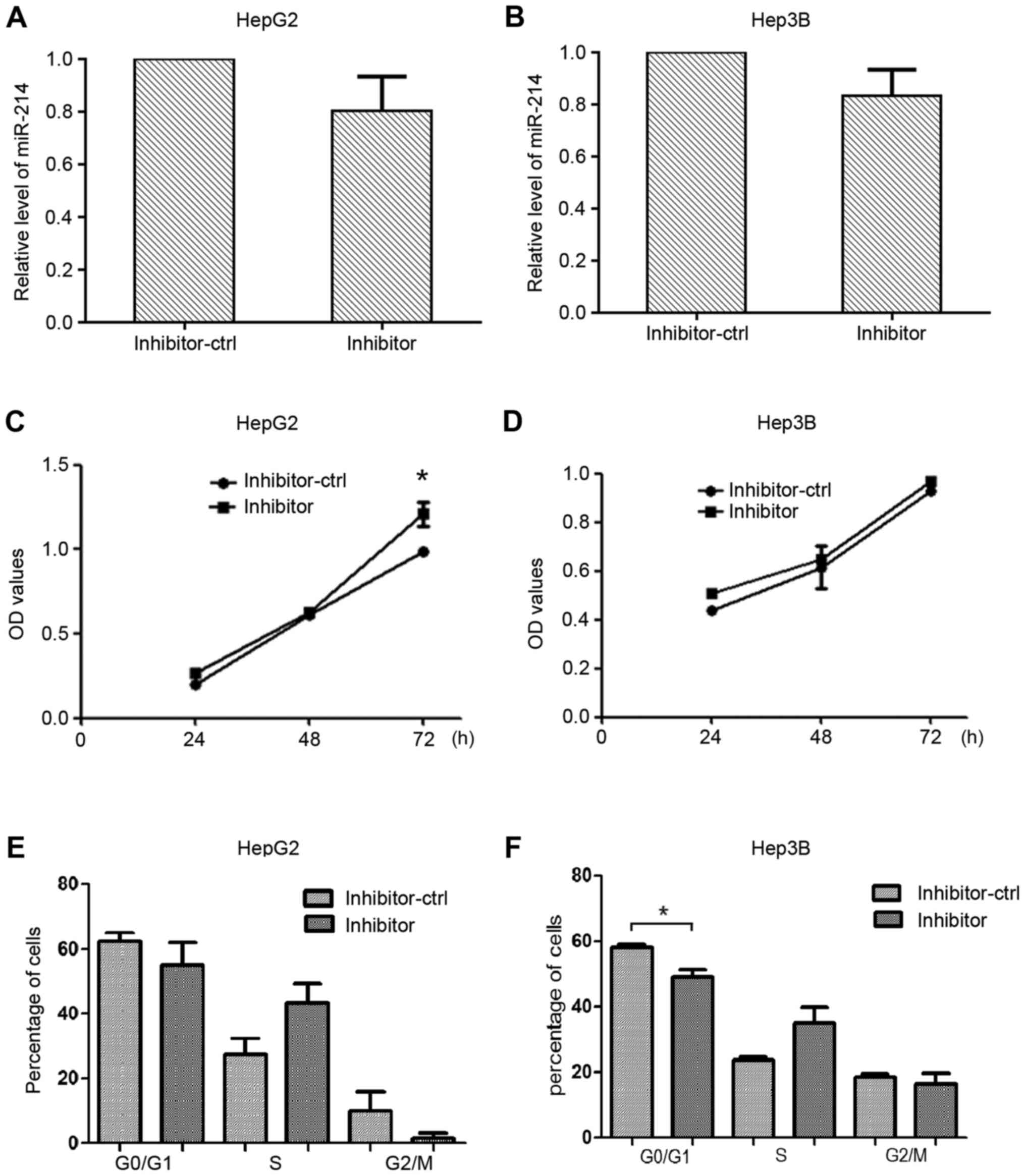MicroRNA‑214 targets Wnt3a to suppress liver cancer cell proliferation
- Authors:
- Published online on: September 13, 2017 https://doi.org/10.3892/mmr.2017.7483
- Pages: 6920-6927
Abstract
Introduction
Hepatocellular carcinoma (HCC) is one of the most common types of malignancy worldwide, with ~630,000 new cases reported each year (1). HCC development is a complex process that is associated with numerous risk factors, including several known environmental factors, hepatitis, and alcohol and tobacco consumption (2,3). There is increasing evidence supporting the role of genetic factors in HCC risk (4). The lack of novel therapeutic strategies for the treatment of HCC emphasizes the need to determine the molecular mechanisms underlying liver cancer development. MicroRNAs (miRNAs/miRs) are a class of endogenous, non-coding RNAs 18–22 nucleotides in length, which are crucial for gene expression regulation (5). In the present study, differential miRNA expression between tumor tissues and normal tissues was identified to be associated with cancer progression via target gene regulation. More than half of miRNAs are located in tumor-associated genomic regions or fragile sites (6), and miRNAs may be classified as tumor suppressors or oncogenes based on their modulation of oncogenic and tumor suppressor pathways (7). Numerous miRNAs are involved in liver cancer development, proliferation, apoptosis and differentiation (8). For example, miR-150-5p inhibits hepatoma cell migration and invasion by targeting matrix metalloproteinase 14 (9) and miR-486-5p suppresses tumor growth in HCC by targeting phosphatidylinositol 3-kinase regulatory subunit α (10).
The present study demonstrated that miR-214 expression is lower in HCC tissues and liver cancer cell lines compared with in matched normal tissues and the HL-7702 cell line, indicating its role as a tumor suppressor in liver cancer. In addition, Wnt3a was confirmed as a target gene of miR-214. Using immunohistochemistry, the present study indicated that the expression of Wnt3a was higher in HCC tissues compared with in normal tissues. In addition, the function of miR-214 in liver cancer cell proliferation was investigated, and overexpression of miR-214 and Wnt3a silencing arrested the liver cancer cell cycle at G1 phase. These results demonstrated that miR-214 may suppress the growth of liver cancer cells by targeting Wnt3a.
Materials and methods
Human tissue samples and cell lines
The SMMC-7721, HepG2 and Hep3B liver cancer cell lines, and the HL-7702 normal liver cell line were provided by the Key University, Ministry of Education (Xi'an, China). These cells were cultured in Dulbecco's modified Eagle's medium (Thermo Fisher Scientific, Inc., Waltham, MA, USA) supplemented with 10% fetal bovine serum (Thermo Fisher Scientific, Inc.) at 37°C in a humidified chamber containing 5% CO2. Tumor tissues and matched normal tissues were obtained from 24 HCC patients (19 males, 5 females; age, 21–72 years). Patients were enrolled between September 2011 and January 2013 at the First Affiliated Hospital of Xi'an Jiaotong University (Xi'an, China). All patients provided written informed consent. The present study was approved by the Medical Ethical Committee of the College of Medicine, Xi'an Jiaotong University (Xi'an, China).
RNA extraction and reverse transcription-quantitative polymerase chain reaction (RT-qPCR)
Total RNA was extracted using TRIzol (Invitrogen; Thermo Fisher Scientific, Inc.) from the cells or tissues according to the manufacturer's protocol. cDNA synthesis was performed using the Prime-Script RT reagent kit (Takara Biotechnology Co., Ltd., Dalian, China) according to the manufacturer's protocol. qPCR was performed on cDNA using SYBR Premix Ex Taq (Takara Biotechnology Co., Ltd.) according to the manufacturer's protocol. PCR amplification was performed on a FTC-3000TM system (Funglyn Biotech Inc., Toronto, ON, Canada). Thermocycling conditions were as follows: Initial denaturation at 95°C for 30 sec, followed by 40 cycles at 95°C for 5 sec and at 60°C for 30 sec. U6 was used for normalization in miRNA detection. The 2−ΔΔCq method was used to quantify the relative expression levels of miR-214 (11). The primer sequences are listed in Table I.
Plasmid vector constructs
EcoRI and HindIII sites were inserted into the multiple cloning sites of the pcDNA6.2-GW/EmGFP vector (Invitrogen; Thermo Fisher Scientific, Inc.). The primary miR-214 sequence was amplified by PCR from genomic DNA, as aforementioned, and then cloned into the EcoRI and HindIII sites of the pcDNA6.2-GW/EmGFP vector. The wild-type (wt) and mutant (mut) Wnt3a 3′ untranslated region (UTR) sequences with SacI and XhoI restriction enzymes were synthesized by Sangon Biotech. Co., Ltd. (Shanghai, China) and cloned between the SacI and XhoI sites of pmirGLO Dual-Luciferase miRNA Target Expression Vector (Promega Corporation, Madison, WI, USA). The 3′UTR sequences are listed in Table I. Wnt3a was cloned into a GV230 vector (Shanghai GeneChem Co., Ltd., Shanghai, China).
Luciferase activity assay
Potential target genes for miR-214 were predicted using RegRNA online software version 2.0 (http://regrna2.mbc.nctu.edu.tw). A potential miR-214-binding site in the 3′-UTR of Wnt3a mRNA was identified. To determine whether Wnt3a was a direct target of miR-214, HepG2 cells were co-transfected with miR-214 and wt Wnt3a 3′UTR or mut Wnt3a 3′UTR pmirGLO plasmid, using Lipofectamine 2000 (Invitrogen; Thermo Fisher Scientific, Inc.) as the transfection reagent, according to manufacturer's protocol. HepG2 cells co-transfected with miR-214 and pmirGLO vector were used as the control. After 48 h, luciferase activity was detected using the Dual-Luciferase Reporter Assay system (Promega Corporation) according to the manufacturer's protocol.
Cell proliferation assay
Cells were seeded into 96-well plates at a density of 5,000 cells/well. Cells were transfected with miR-214, miR-214 inhibitor, small interfering RNA(si) Wnt3a, or their respective controls using Lipofectamine 2000 as the transfection reagent, according to manufacturer's protocol. The miR-214 inhibitor was synthesized by Sangon Biotech Co., Ltd. The siWnt3a and the corresponding control (ctrl) siRNA were purchased from Shanghai GenePharma Co., Ltd. (Shanghai, China). Cell Counting kit-8 (CCK8; 7Sea Biotech, Shanghai, China) assay was performed according to the manufacturer's protocol. Optical density at 450 nm was measured 24, 48 and 72 h post-transfection using the FLUOstar OPTIMA microplate reader (BMG Labtech GmbH, Ortenberg, Germany), in order to measure cell proliferation.
Cell cycle analysis
HepG2 and Hep3B cells were transfected with miR-214, miR-control (ctrl), miR-214 inhibitor, inhibitor-ctrl, siWnt3a or si-ctrl (Shanghai GenePharma Co., Ltd.) using Lipofectamine 2000 according to the manufacturer's instructions. At 48 h post-transfection, 1×106 cells were harvested and washed in PBS, then fixed with 70% ice-cold ethanol at 4°C overnight. The cells were washed in PBS and then incubated at 4°C with 0.1 mg/ml RNase A and 0.05 mg/ml propidium iodide (PI; Sigma-Aldrich; Merck KGaA, Darmstadt, Germany) for 30 min. Fluorescence-activated cell sorting was performed using a BD FACSort flow cytometer (BD Biosciences, Franklin Lakes, NJ, USA). ModFit LT version 4.0 (Verity Software House, Inc., Topsham, ME, USA) was used to analyze cell cycle distributions.
Immunohistochemistry
Formaldehyde-fixed, paraffin-embedded tissue samples were sectioned at 5 µm, after which the samples were deparaffinized in xylene and hydrated using graded alcohol. Antigen retrieval was performed with citrate buffer 0.01 M (pH 6.0), followed by blocking endogenous peroxidases with 3% H2O2 for 20 min, and blocking of non-specific binding with normal goat serum (Beijing Biosynthesis Biotechnology Co., Ltd., Beijing, China) at room temperature for 20 min. The slides were then incubated with anti-Wnt3a primary antibodies [FT20][a21](1:100; Beijing Biosynthesis Biotechnology Co., Ltd., Beijing, China, bs-1700R) at 4°C overnight, followed by incubation with the HRP-conjugated secondary antibody (Beijing ZhongShan-Golden Bridge Biological Technology Co., Ltd., Beijing, China) [FT22][a23] for 30 min at 37°C. Detection was performed using 3,3′-diaminobenzidine [FT25][a26] for 3 min at room temperature (Beijing ZhongShan-Golden Bridge Biological Technology Co., Ltd., Beijing, China) and Harris hematoxylin [FT27][a28] for 30 sec at room temperature. Finally, a Leica Photo Microscope (Leica Microsystems GmbH, Wetzlar, Germany) was used to obtain digital images.
Western blot analysis
Total proteins were extracted using radioimmunoprecipitation assay lysis buffer (Xi'an Wolsen Biotechnology Co., Ltd., Xi'an, China). Protein concentration was determined using a NanoDrop ND-1000 spectrophotometer (NanoDrop; Thermo Fisher Scientific, Inc., Wilmington, DE, USA). Equal amounts (30 µg) of extracted protein samples were separated by 10% SDS-PAGE and were then transferred onto a polyvinylidene fluoride membrane, which was blocked with 5% non-fat milk in TBS containing 0.05% Tween-20 (TBST) for 1 h at room temperature. Membranes were then incubated with rabbit anti-human Wnt3a (cat no. bs-1700R; 1:100; Beijing Biosynthesis Biotechnology Co., Ltd.) and rabbit anti-human GAPDH (cat no. 10494-1-AP; 1:2,000; ProteinTech Group, Inc., Chicago, IL, USA) at 4°C overnight. Subsequently, the membrane was washed 3 times with TBST and incubated with secondary goat anti-rabbit antibody (cat no. 111-035-144; 1:1,000; Jackson ImmunoResearch Laboratories, Inc., West Grove, PA, USA) for 2 h at room temperature. Protein bands were visualized using Immobilon Western Chemiluminescent HRP substrate (EMD Millipore, Billerica, MA, USA). Blots were semi-quantified by densitometry using Quantity One imaging software (Bio-Rad Laboratories, Inc., Hercules, CA, USA).
Statistical analysis
Statistical analysis was performed with SPSS software version 13.0 (SPSS, Inc., Chicago, IL, USA). Student's t-test or one-way analysis of variance followed by a post hoc Tukey test were used to analyze the data from three independent experiments. P<0.05 was considered to indicate a statistically significant difference.
Results
miR-214 is downregulated in liver cancer and targets Wnt3a
To explore the expression of miR-214 in liver cancer development, the expression levels of miR-214 were detected in 24 pairs of HCC and matched normal tissue samples using RT-qPCR. miR-214 was significantly downregulated in HCC tissue samples compared with in matched non-tumor tissues, as presented in Fig. 1A. In addition, miR-214 was downregulated in the examined liver cancer cells (SMMC-7721, Hep3B, HepG2) compared with in normal HL-7702 hepatocytes (Fig. 1B). These findings suggested that miR-214 was downregulated in HCC tissues and liver cancer cell lines; therefore, miR-214 may act as a potential anti-oncogenic miRNA in liver cancer.
The prediction of miR-214 targets was acquired using RegRNA. Wnt3a was identified as a potential target gene of miR-214. A miR-214 binding site was identified in the 3′UTR of Wnt3a (Fig. 1C). Immunohistochemistry demonstrated that Wnt3a protein expression was increased in HCC samples compared with in normal tissues (Fig. 1D). The protein expression levels of Wnt3a were also measured by western blotting in HepG2 cells transfected with miR-214 or miR-ctrl, and the results demonstrated that miR-214 overexpression was able to reduce Wnt3a protein expression (Fig. 1E). Dual-luciferase reporter assay was employed to determine whether Wnt3a was a direct target of miR-214. Luciferase activity was significantly reduced following co-transfection with miR-214 and wt Wnt3a 3′UTR compared with the control; however, luciferase activity was not altered following co-transfection with miR-214 and mut Wnt3a 3′UTR (Fig. 1F). These results provided direct evidence that Wnt3a was a target of miR-214.
miR-214 suppresses liver cancer cell growth via Wnt3a targeting
To explore the role of miR-214 in liver cancer cell growth, HepG2 and Hep3B cells were transfected with miR-214, miR-ctrl, siWnt3a or si-ctrl. Overexpression of miR-214 suppressed the growth of HepG2 and Hep3B cells following transfection for 24, 48 and 72 h compared with control vector-transfected cells (Fig. 2A and B). The results of Wnt3a silencing were consistent with those of miR-214 overexpression. Based on CCK8 assays (Fig. 2C and D), siWnt3A inhibited the growth of HepG2 and Hep3B cells. To further demonstrate that miR-214 suppressed the growth of HepG2 and Hep3B by targeting Wnt3a, Wnt3a overexpression vector and miR-ctrl or miR-214 were co-transfected into HepG2 and Hep3B cells. The results demonstrated that overexpression of Wnt3a can mitigate the growth inhibition caused by overexpression of miR-214 (Fig. 2E and F).
Overexpression of miR-214 and silencing of Wnt3a inhibits liver cancer cell proliferation via cell cycle regulation
HepG2 and Hep3B cells were transfected with miR-214 or miR-ctrl, and siWnt3a or si-ctrl. Cell cycle distribution, as detected by flow cytometry, revealed an accumulation of HepG2 and Hep3B cells in G1 phase in the miR-214 overexpression groups compared with the miR-ctrl groups (Fig. 3A and B). In addition, the number of cells in G1 phase was increased following transfection with siWnt3a compared with the control groups (Fig. 3C and D). These results suggested that overexpression of miR-214 or Wnt3a silencing may induce G1 cell cycle arrest.
Knockdown of miR-214 contributes to liver cancer cell proliferation
miR-214 inhibitor was used to further investigate the effects of miR-214 silencing on liver cancer cell proliferation. HepG2 and Hep3B cells were transfected with miR-214 inhibitor or inhibitor-ctrl, and the expression levels of miR-214 were detected (Fig. 4A and B). Cell viability was measured using the CCK8 assay; transfection with the miR-214 inhibitor increased the proliferation of HepG2 cells compared with the control group (Fig. 4C and D). The number of cells in G1 phase was reduced in the Hep3B cells transfected with miR-214 inhibitor compared with the control group (Fig. 4E and F).
Discussion
Previous studies have supported the role of miRNAs in tumorigenesis, including human liver cancer, and their functions as tumor suppressors or oncogenes (12,13). These small non-protein-coding RNAs are able to target numerous genes, including oncogenes, leading to the degradation of target mRNAs and inhibition of translation (14). miRNA dysregulation is associated with human cancer; specifically, miR-214 is a tumor suppressor of HCC (15). The present study revealed that miR-214 is downregulated in HCC cancer tissues and liver cancer cell lines, and may act as a tumor suppresser via Wnt3a signaling.
The Wnt/β-catenin signaling pathway is highly conserved and serves an essential role in regulating a series of genes associated with processes including embryonic development, stem cell maintenance and tissue homeostasis, and its disruption is a common cause of numerous types of cancer (16–18). In addition, the pathway is important during the development of HCC (19). Previous studies have demonstrated that β-catenin-activating mutations may associate with HCC, thus establishing an association between Wnt signaling and HCC (20,21) and providing novel insight into the complex network underlying HCC. Wnts act through distinct canonical and noncanonical pathways (22). The canonical Wnt/β-catenin signaling pathway is involved in the transition from cell proliferation to myogenic differentiation (23). β-catenin is a central regulator in the Wnt/β-catenin pathway (24,25) and is present in the plasma membrane, cytoplasm and nucleus. The interplay between the cell cycle and Wnt signaling is complex and requires further study (26,27). Wnt3a is a member of the Wnt family located on human chromosome 17 (17q21) and is an important molecule in the Wnt/β-catenin pathway that can active the canonical Wnt signaling pathway (28). The overexpression of Wnt3a expression serves an important role in hepatocarcinogenesis (29).
In conclusion, the present study demonstrated that Wnt3a is a target gene of miR-214. In addition, the results indicated that miR-214 may inhibit cell proliferation in liver cancer cells via Wnt3a targeting. These data provide experimental evidence to suggest that miR-214 acts as a tumor suppressor by suppressing the Wnt/β-catenin signaling pathway. Therefore, miR-214 may be considered a potential molecular therapeutic target for the treatment of liver cancer.
Acknowledgements
The present study was supported by the Scientific Research and Sharing Platform Construction Project of Shaanxi Province (grant no. 2015FWPT-14) and Research Support Project of New Teacher of Xi'an Jiaotong University (grant no. YX1K078).
References
|
Kew MC: Epidemiology of chronic hepatitis B virus infection, hepatocellular carcinoma, and hepatitis B virus-induced hepatocellular carcinoma. Pathol Biol (Paris). 58:273–277. 2010. View Article : Google Scholar : PubMed/NCBI | |
|
Sherman M: Hepatocellular carcinoma: New and emerging risks. Dig Liver Dis. 42 Suppl 3:S215–S222. 2010. View Article : Google Scholar : PubMed/NCBI | |
|
Dragani TA: Risk of HCC: Genetic heterogeneity and complex genetics. J Hepatol. 52:252–257. 2010. View Article : Google Scholar : PubMed/NCBI | |
|
Feo F, De Miglio MR, Simile MM, Muroni MR, Calvisi DF, Frau M and Pascale RM: Hepatocellular carcinoma as a complex polygenic disease. Interpretive analysis of recent developments on genetic predisposition. Biochim Biophys Acta. 1765:126–147. 2006.PubMed/NCBI | |
|
Rajendiran S, Parwani AV, Hare RJ, Dasgupta S, Roby RK and Vishwanatha JK: MicroRNA-940 suppresses prostate cancer migration and invasion by regulating MIEN1. Mol Cancer. 13:2502014. View Article : Google Scholar : PubMed/NCBI | |
|
Calin GA, Liu CG, Sevignani C, Ferracin M, Felli N, Dumitru CD, Shimizu M, Cimmino A, Zupo S, Dono M, et al: MicroRNA profiling reveals distinct signatures in B cell chronic lymphocytic leukemias. Proc Natl Acad Sci USA. 101:11755–11760. 2004; View Article : Google Scholar : PubMed/NCBI | |
|
Ventura A and Jacks T: MicroRNAs and cancer: Short RNAs go a long way. Cell. 136:586–591. 2009. View Article : Google Scholar : PubMed/NCBI | |
|
Wiemer EA: The role of microRNAs in cancer: No small matter. Eur J Cancer. 43:1529–1544. 2007. View Article : Google Scholar : PubMed/NCBI | |
|
Li T, Xie J, Shen C, Cheng D, Shi Y, Wu Z, Zhan Q, Deng X, Chen H, Shen B, et al: miR-150-5p Inhibits Hepatoma cell migration and invasion by targeting MMP14. PLoS One. 9:e1155772014. View Article : Google Scholar : PubMed/NCBI | |
|
Huang XP, Hou J, Shen XY, Huang CY, Zhang XH, Xie YA and Luo XL: MicroRNA-486-5p, which is downregulated in hepatocellular carcinoma, suppresses tumor growth by targeting PIK3R1. FEBS J. 282:579–594. 2015. View Article : Google Scholar : PubMed/NCBI | |
|
Livak KJ and Schmittgen TD: Analysis of relative gene expression data using real-time quantitative PCR and the 2(-Delta Delta C(T)) method. Methods. 25:402–408. 2001. View Article : Google Scholar : PubMed/NCBI | |
|
Kerr TA, Korenblat KM and Davidson NO: MicroRNAs and liver disease. Transl Res. 157:241–252. 2011. View Article : Google Scholar : PubMed/NCBI | |
|
Huang S and He X: The role of microRNAs in liver cancer progression. Br J Cancer. 104:235–240. 2011. View Article : Google Scholar : PubMed/NCBI | |
|
Di Leva G and Croce CM: miRNA profiling of cancer. Curr Opin Genet Dev. 23:3–11. 2013. View Article : Google Scholar : PubMed/NCBI | |
|
Shih TC, Tien YJ, Wen CJ, Yeh TS, Yu MC, Huang CH, Lee YS, Yen TC and Hsieh SY: MicroRNA-214 downregulation contributes to tumor angiogenesis by inducing secretion of the hepatoma-derived growth factor in human hepatoma. J Hepatol. 57:584–591. 2012. View Article : Google Scholar : PubMed/NCBI | |
|
Zeng XC, Liu FQ, Yan R, Yi HM, Zhang T, Wang GY, Li Y and Jiang N: Downregulation of miR-610 promotes proliferation and tumorigenicity and activates Wnt/β-catenin signaling in human hepatocellular carcinoma. Mol Cancer. 13:2612014. View Article : Google Scholar : PubMed/NCBI | |
|
Reya T and Clevers H: Wnt signalling in stem cells and cancer. Nature. 434:843–850. 2005. View Article : Google Scholar : PubMed/NCBI | |
|
Gheinani A Hashemi, Burkhard FC, Rehrauer H, Fournier C Aquino and Monastyrskaya K: MicroRNA miR-199a-5p regulates smooth muscle cell proliferation and morphology by targeting Wnt2 signaling pathway. J Biol Chem. 13:7067–7086. 2015. View Article : Google Scholar | |
|
Qu B, Liu BR, Du YJ, Chen J, Cheng YQ, Xu W and Wang XH: Wnt/β-catenin signaling pathway may regulate the expression of angiogenic growth factors in hepatocellular carcinoma. Oncol Lett. 7:1175–1178. 2014.PubMed/NCBI | |
|
de La Coste A, Romagnolo B, Billuart P, Renard CA, Buendia MA, Soubrane O, Fabre M, Chelly J, Beldjord C, Kahn A and Perret C: Somatic mutations of the beta-catenin gene are frequent in mouse and human hepatocellular carcinomas. Proc Natl Acad Sci USA. 95:8847–8851. 1998; View Article : Google Scholar : PubMed/NCBI | |
|
Miyoshi Y, Iwao K, Nagasawa Y, Aihara T, Sasaki Y, Imaoka S, Murata M, Shimano T and Nakamura Y: Activation of the beta-catenin gene in primary hepatocellular carcinomas by somatic alterations involving exon 3. Cancer Res. 58:2524–2527. 1998.PubMed/NCBI | |
|
Shi X and Garry DJ: Muscle stem cells in development, regeneration, and disease. Genes Dev. 20:1692–1708. 2006. View Article : Google Scholar : PubMed/NCBI | |
|
Tanaka S, Terada K and Nohno T: Canonical Wnt signaling is involved in switching from cell proliferation to myogenic differentiation of mouse myoblast cells. J Mol Signal. 6:122011. View Article : Google Scholar : PubMed/NCBI | |
|
Anastas JN and Moon RT: WNT signalling pathways as therapeutic targets in cancer. Nat Rev Cancer. 13:11–26. 2013. View Article : Google Scholar : PubMed/NCBI | |
|
Li D, Liu W, Wang X, Wu J, Quan W, Yao Y, Bals R, Ji S, Wu K, Guo J and Wan H: Cathelicidin, an antimicrobial peptide produced by macrophages, promotes colon cancer by activating the Wnt/β-catenin pathway. Oncotarget. 6:2939–2950. 2015. View Article : Google Scholar : PubMed/NCBI | |
|
Gougelet A and Colnot S: A complex interplay between Wnt/β-catenin signalling and the cell cycle in the adult liver. Int J Hepatol. 2012:8161252012. View Article : Google Scholar : PubMed/NCBI | |
|
He TC, Sparks AB, Rago C, Hermeking H, Zawel L, da Costa LT, Morin PJ, Vogelstein B and Kinzler KW: Identification of c-MYC as a target of the APC pathway. Science. 281:1509–1512. 1998. View Article : Google Scholar : PubMed/NCBI | |
|
Constantinou T, Baumann F, Lacher MD, Saurer S, Friis R and Dharmarajan A: SFRP-4 abrogates Wnt-3a-induced beta-catenin and Akt/PKB signalling and reverses a Wnt-3a-imposed inhibition of in vitro mammary differentiation. J Mol Signal. 3:102008. View Article : Google Scholar : PubMed/NCBI | |
|
Pan LH, Yao M, Cai Y, Gu JJ, Yang XL, Wang L and Yao DF: Oncogenic Wnt3a expression as an estimable prognostic marker for hepatocellular carcinoma. World J Gastroenterol. 22:3829–3836. 2016. View Article : Google Scholar : PubMed/NCBI |













